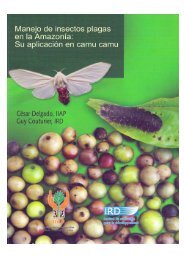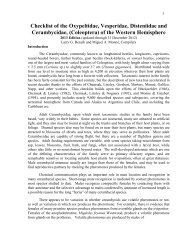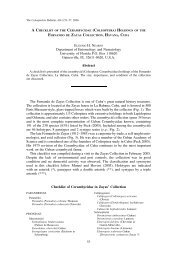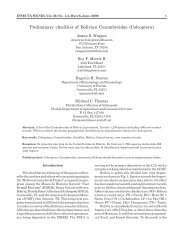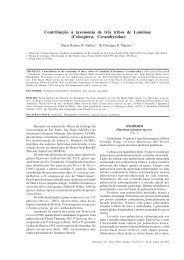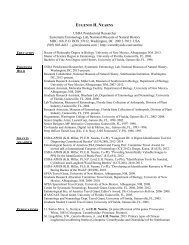You also want an ePaper? Increase the reach of your titles
YUMPU automatically turns print PDFs into web optimized ePapers that Google loves.
128 THE TRIBE ONCIDERINr<br />
Type locality.-Brazil.<br />
Distribution.-Southeastern Brazil.<br />
BRAZIL: ; Han$.'l Humboldt, Santa. Catharina, November, 1940; (A. Maller) ; [L.<br />
Lacy.]. 2 2; Rio de Janeiro; [C.M.] . ; Nova Friburgo, R. J.; [M.C.Z.],<br />
No LOCALtTY DATA : 5; [lVI.C.Z.],<br />
Glypthaga xylina Bates<br />
PLAn: V, FIGURE 13.<br />
HesrJcM xylina Bates, Ann. Mag. Nat. Rist., (3), XVI, 1865, p. 172.<br />
lschiocentra xylina Bates. Lacordaire, Gen. Col., IX, 1872, p. 674.<br />
RatIwr elongate and morc slender than most members of the<br />
tribe'; elyt1'6 with a number of arcuate, more or less parallel vittae<br />
of whitish and brown ; antennae in male elongate, slender, apical<br />
segments paler ; and fifth sternite nearly entirely pale.<br />
MALE. Elongate-Qblong, cylindrical, moderately robust, el1rn subconvex;<br />
fuscous or blnck, all over fulvous and grayish-brown variegated. Front sometimes<br />
entirely grayish-brown pubescent. Pronotum above lateral tubercle with II glabrous,<br />
narrow, subarcuate vitta from just behind middle at base. Scutellum dark brown<br />
pubescent, with a pale fulvous vitta one-third its width at middle. Elytra at middle<br />
of base with a narrow, d:uk bro\VD vitta (a continuation of one on pronotum)<br />
which becomes forked very Ilear base and ends on bas.'ll one-fifth, the outer prong<br />
of the fork being the shorter; either side along suture II I1!lrrow, black vittn from<br />
scutellum to apex, from either humerus an irregular, arcuate, whitish vitta, much<br />
wider at humeri, apices not touching suture, slightly lateral to this a narrow, black,<br />
arcuate vitta which does not attain either humeri or apices, on extreme lateral edge<br />
II rather broad, indistinct, whitish vitta in the middle onc.half. Beneath fwcous or<br />
black, dark grayish-brown pubescent; mesosternum narrowly and metasternum<br />
broadly, fulvous and grayish variegated; abdomen with sternites somewhat indis<br />
tinctly streaked with fulvous and grayish; and at extreme lateral edge with irregular,<br />
elongate, fulvous and whitish maculae, an indistinct row of smaller ones more toward<br />
middle,' fifth stcrnite broadly vittate with whitish-fulvous leaving only a very<br />
narrow line dark grayish-brown medially. Legs fuscous or black, variegated with<br />
dense, whitish and fulvous pubescence. Antennae with seape dark reddish-brown to<br />
fuscous, remaining segments paler; scape with whitish and fulvous pubescence,<br />
third segment with basal half grayish, apical haH grayisb-brown, each succeeding<br />
segmcnt with same color pubescence but the gray portion becoming increasingly<br />
broader.<br />
Head above with a median impressed line from occiput to near middle of front;<br />
front slightly transverse, attenuate just below lower lobe of eyes, disk finely alu<br />
,taceous, with scattered, coarse, deep punctures, these slightly more 6umerous laterally,<br />
between antennni tubercles feebly concave; genne elongate, much narrower<br />
above, surface finely alutaceous, with a few, coarse, deep punctures; eye with lower<br />
lobe oblong-ovnte, about one-fourth longer than gena; antennal tubercles only mod-



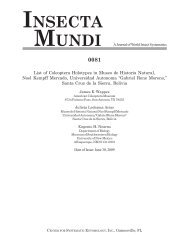
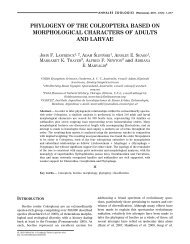


![Coleoptera. Vol. I. [Longicornia. Part I.]](https://img.yumpu.com/41202793/1/180x260/coleoptera-vol-i-longicornia-part-i.jpg?quality=85)
